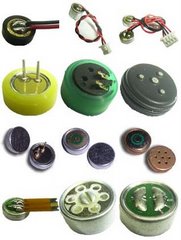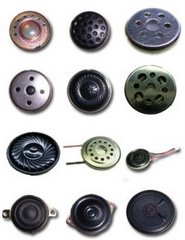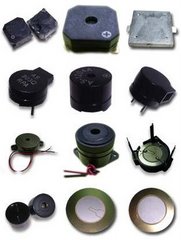1. Transform sound into electric signal- The best design in theory:
The design of electret condenser microphones is based on the theorem that we use charging and discharging motion
between electric capacity conductors. When the ultra-thin or gold-plating Mylar diaphragm response to the sound
pressure level, it changes the static electricity between the conductors into electric signal directly. Then we can gain
a proper output of impedance and sensitivity by the electric circuit coupling.
1、能將聲音直接轉換成電能訊號的最佳設計原理:
電容式麥克風是利用導體間的電容充放電原理,以超薄的金屬或鍍金的塑膠薄膜為振動膜感應音壓,
以改變導體間的靜電壓直接轉換成電能訊號,經由電子電路耦合獲得實用的輸出阻抗及靈敏度設計而成。
2. The characteristic of reappearing the original sound:
To reappear the original sound is the highest performance for the acoustic specialist to achieve. If we check the basic
design of the microphone, we can find a electret condenser microphone can transform the sound into electric signal
directly, because it is not only manufactured with accurate mechanism technique, but also combine complicated electric
circuit. Therefore, with the excellent characteristic in advance, the electret condenser microphone must be your best choice.
2、能展現『原音重現』的特性:
音響專家以追求『原音重現』為音響的最高境界!從麥克風的基本設計原理分析,不難發現電容式麥克風
不僅靠精密的機構製造技術,而且結合複雜的電子電路,能直接將聲音轉換成電能訊號,先天上就具有極
優越的特性,所以成為追求『原音重現』者的最佳選擇。
3. Very wild frequency response:
Diaphragm is a main component of a microphone to sense the sound and to transform it into the electric signal.
The material and the mechanical design of the diaphragm decide the acoustics of a microphone. Due to the material
of the diaphragm is very thin and light, and can transform the sound into electric signal directly; the range of the
frequency response can reach to the ultra-low frequency (under 10 Hz), and the high frequency can also gets to
supersonic easily, which shows the characteristic of wild frequency response.
3、具有極為寬廣的頻率響應:
振動膜是麥克風感應聲音及轉換為電能訊號的主要元件。振動膜的材質及機構設計,是決定麥克風音質的
各項特性。由於電容式麥克風的振動膜可以採用極輕薄的材料製成,而且感應的音壓,直接轉換成音頻訊
號,所以頻率響應低音可以延伸到10Hz以下的超低頻,高音可以輕易的達到數十KHz的超音波,展現非常
寬廣的頻率響應特性!
The diaphragm of the dynamic microphone loads a sound coil which is hundreds times heavier than itself. (Left picture)
The diaphragm of the electret condenser microphone works without any load. (Right picture)
動圈式麥克風的振動膜(左)負載了比本身重達幾百倍以上的音圈,
電容式麥克風的振動膜(右圖)沒有任何負載
訂閱:
張貼留言 (Atom)




2 則留言:
hey your blog design is very nice, neat and fresh and with updated content, make people feel peace and I always enjoy browsing your site.
- Murk
Most audio subsystems in today’s consumer and communications devices use electret condenser microphones (ECMs). These devices comprise a fixed backplate with a non-conductive precharged layer attached and a flexible membrane, usually made of a metalized Mylar. The backplate and the membrane, which moves in response to sound, form a capacitor.
Movement of the membrane changes the capacitance, resulting in a change in output voltage. A small three-terminal JFET mounted inside the microphone canister serves as a buffer between the capacitive sensor and the output. An external pre-amplifier is often used to deliver the signal to an analog-to-digital converter (ADC).
Historically, system designers have employed ECMs because they are readily available from multiple suppliers and have offered an affordable solution. Most recent ECM development efforts have focused on lowering cost and reducing footprint, but manufacturers have achieved little success improving microphone sensitivity, SNR, and linearity.
As a result, while ECM technology provided an adequate solution for consumer electronics applications in the past, today it presents a number of performance limitations. The technology consumes relatively high amounts of power, a key concern for designers of battery-powered mobile systems. Power-supply rejection (PSR), or the ability to suppress noise on the power supply, is also relatively poor.
The poor PSR limits a designer’s flexibility in placing the microphone due to concerns about noise generated from other system components such as the LCD. Designers using ECMs can compensate for the technology’s poor PSR by adding a low-dropout regulator (LDO) to generate clean power for the microphone. Yet this approach increases system component count, driving up system footprint, power requirements, and cost.
Moreover, ECM technology entails some additional hidden costs. First, the use of electrets often requires hand assembly, which adds additional time and cost to the manufacturing process. ECMs also require a number of other supporting components such as a discrete converter and a preamp. These additional devices drive up board real estate requirements and increase power consumption and cost.
Furthermore, electrets cannot offer the tight tolerances and repeatable part-to-part performance that system designers enjoy with components manufactured in today’s photolithography-defined semiconductor processes. The sensitivity and frequency response of an ECM can vary significantly from device to device as well as over temperature, making it difficult for system designers to match components for basic applications such as stereo.
To compensate for this weakness, manufacturers building multi-microphone designs for such applications must often hand-sort ECMs in an attempt to better match components. This, in turn, drives up costs and further complicates the manufacturing process.
System manufacturers have begun shifting to surface-mountable electrets to eliminate some of these issues. However, the industry-wide migration to lead-free soldering has presented additional obstacles. Higher reflow temperatures used in lead-free manufacturing degrade electret performance, and manufacturers often have been forced to run multiple reflow operations to reduce the impact of the reflow process on electret performance.
張貼留言